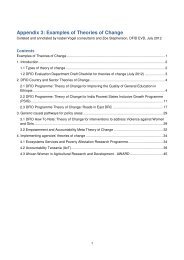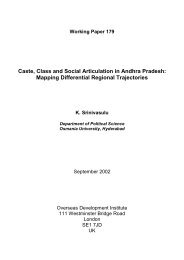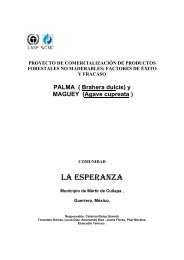Full Report - Research for Development - Department for ...
Full Report - Research for Development - Department for ...
Full Report - Research for Development - Department for ...
Create successful ePaper yourself
Turn your PDF publications into a flip-book with our unique Google optimized e-Paper software.
Synthesis results<br />
Four studies focused on the induction of labour. Two of these focused on induction<br />
<strong>for</strong> women with eclampsia (Nahar et al., 2004 (-)/(-); Tukur et al., 2007 (+)/(-)) by<br />
means of misoprostol (50mg). There did not appear to be any advantage of<br />
misoprostol in terms of mortality in either study, although Nahar et al. (2004) (-)/(-<br />
); was able to conclude that intravaginal misoprostol was well tolerated and<br />
effective in the induction of labour. The third study considered induction of labour<br />
in the context of women going beyond 42 weeks gestation (Bergsjo et al., 1989) (-<br />
)/(-). Induction by stripping of membranes and intravenous oxytocin infusion in this<br />
context offered no advantage as measured by perinatal mortality. Abdul et al.<br />
(2007) (-)/(+) compared misoprostol to oxytocin as drugs <strong>for</strong> induction during the<br />
third stage of labour. No deaths were recorded in either group and the efficacy of<br />
misoprostol was judged to be comparable to oxytocin.<br />
Three studies concerned the assessment of micronutrient supplements. These have<br />
been classified under ‘drug treatments’ as they were prescribed within a clinical<br />
setting. Fawzi et al. (2007) (++)/(++) compared daily multivitamins (vitamins B, C, E)<br />
with a placebo group in HIV-negative women in Tanzania. No benefits were found in<br />
terms of risk of prematurity and foetal death in the treatment group but there was<br />
significantly reduced risk of low birthweight (LBW) compared to the placebo group.<br />
Kaestel et al. (2005) (++)/(++) compared different levels of micronutrient<br />
supplements <strong>for</strong> pregnant women in Guinea-Bissau but found no differences in<br />
perinatal or neonatal mortality. Kupka et al. (2008) (++)/(-) also found no significant<br />
effect of selenium supplementation <strong>for</strong> HIV-infected pregnant women in terms of<br />
maternal or neonatal mortality.<br />
Ndibazza et al. (2010) (++)/(+) and de Silva et al. (1999) (+)/(++) evaluated the<br />
impact of the use of anthelmintics to expel parasitic worms by women during<br />
pregnancy on perinatal mortality. In Sri Lanka, de Silva et al. (1999) (+)/(++) found<br />
perinatal deaths to be lower in the anthelmintic group, whereas Ndibazza et al.<br />
(2010) (++)/(+) found no overall effect in an area in Uganda where helminth<br />
prevalence was high but infection intensity low.<br />
Two studies focused on the use of antiretrovirals in HIV-infected pregnant women<br />
(Ekouevi et al., 2008 (+)/(-); Walter et al., 2006 (+)/(+)). The use of highly active<br />
antiretroviral treatment (HAART) was found to have no benefit as measured by<br />
stillbirths among women with advanced HIV (Ekouevi et al., 2008) (+)/(-) but<br />
antiretroviral treatment <strong>for</strong> HIV-infected pregnant women with low CD4 counts was<br />
found to significantly decrease neonatal mortality in a study in Zambia.<br />
Two studies focused on the use of antibiotics, but in different contexts. Aboud et al.<br />
(2009) (++)/(+) assessed the effect of giving antibiotics to HIV-infected pregnant<br />
women. No benefits were found in terms of maternal morbidity or mortality.<br />
Bergstrom (1991) (+)/(+) assessed the use of antibiotics in the conservative<br />
management of women with preterm rupture of membranes. Neonatal mortality was<br />
found to be significantly lower than in a control group in which no pharmaceutical<br />
treatment was given but labour was induced.<br />
The remaining papers involved single studies looking at different aspects of drug<br />
treatment: the use of steroids in women with high-risk premature delivery (Fekih et<br />
al., 2002) (+)/(-); use of misoprostol in the active management of third stage of<br />
labour (Afolabi et al., 2010) (+)/(-); use of injectable contraceptive during<br />
pregnancy (Gray and Pardthaisong, 1991) (+)/(+); and administration of the<br />
antimalarial, quinine hydrochloride, <strong>for</strong> pregnant women with malaria (Kietinun et<br />
al., 1993) (-)/(-). All except Gray and Pardthaisong (1991) reported favourable<br />
outcomes <strong>for</strong> the drug treatment evaluated.<br />
What are the effects of different models of delivery <strong>for</strong> improving maternal and infant health<br />
outcomes <strong>for</strong> poor people in urban areas in low income and lower middle income countries? 31









